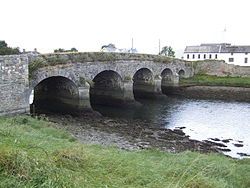world.wikisort.org - Ireland
Annagassan (Irish: Áth na gCasán, meaning 'ford of the paths')[2] is a village in the townland of Ballynagassan, County Louth, Ireland. It sits where the River Glyde enters the Irish Sea.
Annagassan
Áth na gCasán | |
|---|---|
Village | |
 Annagassan bridge | |
 Annagassan Location in Ireland | |
| Coordinates: 53°53′N 6°21′W | |
| Country | Ireland |
| Province | Leinster |
| County | County Louth |
| Population (2016)[1] | 201 |
History
Annagassan was first mentioned as Linn Duachaill in AD 841 when the establishment of a Viking longphort was recorded.[3][4] This has subsequently been confirmed by archaeological work.[5][6]
In 827 the Annals of Ulster record that the Vikings attacked the Ciannachta people of Louth and north Meath. These early raids were sporadic coastal attacks by small seaborne forces; however, from the 830s, a new phase was characterised by larger fleets, which penetrated up navigable rivers and plundered extensive inland areas. There is a legend that one such Viking was stranded after a raid and settled there. The locals believe this Viking heritage is evidenced by the long-held residence of a seafaring man of "mythic proportions" and wild Scandinavian appearance and demeanour, known to the villagers as "The Bear".[citation needed]
Annagassan was once as important as the Viking settlement at Dubh Linn (The Black Pool).[6] The modern village is generally believed to be built on what archaeologists consider to be a man-made polder structure, constructed to provide shelter for the fjord. The original settlement was located further upstream; navigation was considerably easier on the River Glyde in the 9th century before the intervening build-up of sediment.
Transport

Bus Éireann route 168 provides two journeys to Dundalk Mondays to Fridays inclusive and a solitary return journey from Dundalk. The morning outward journey and the return journey serve Dromiskin.[7]
See also
- List of towns and villages in Ireland
References
- "Sapmap Area - Settlements - Annagassan". Census 2016. Central Statistics Office. April 2016. Retrieved 5 February 2020.
- "Annagassan" A Dictionary of British Place-Names. A. D. Mills. Oxford University Press, 2003. Oxford Reference Online. Oxford University Press. Solihull Libraries. 16 April 2008
- Connolly S.J. (1998). The Oxford Companion to Irish History. Oxford University Press. p. 580. ISBN 0-19-211695-9.
- Roesdahl, Else (2016). The Vikings (Third ed.). Penguin Books. p. 234. ISBN 978-0-141-98476-6.
- Keogh, Elaine (10 October 2011). "Unlocking the past: mythical Viking village really exists". Independent.ie. Retrieved 27 October 2011.
- Macauley, Conor (24 October 2011). "Linn Duchaill: Ireland's unlikely Viking capital". BBC News. Retrieved 27 October 2011.
- "Archived copy" (PDF). Archived from the original (PDF) on 20 December 2011. Retrieved 28 December 2011.
{{cite web}}: CS1 maint: archived copy as title (link)
На других языках
- [en] Annagassan
[ru] Аннагассан
Аннагассан[1] (англ. Annagassan; ирл. Áth na gCasán, букв. «брод путей»[2]) — деревня в Ирландии, находится в графстве Лаут (провинция Ленстер). Аннагассан находится на полпути между Дублином и Белфастом. Входит в таунленд Баллинагассан (Ballynagassan). Находится у места впадения реки Глайд в Ирландское море.Другой контент может иметь иную лицензию. Перед использованием материалов сайта WikiSort.org внимательно изучите правила лицензирования конкретных элементов наполнения сайта.
WikiSort.org - проект по пересортировке и дополнению контента Википедии
